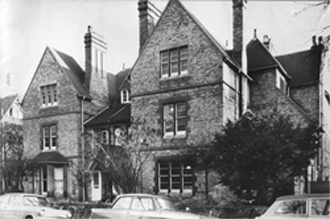


 Photo : Courtesy of K. Ohno; © R. McWeeny |
Charles Alfred Coulson, (1910-1974),
English theoretical chemist who developed a molecular orbital theory and the concept of partial valency. He developed many mathematical techniques for solving chemical and physical problems. Coulson was born in Dudley, Yorkshire, and studied at Cambridge. He became professor of theoretical physics at King's College, London, 1947, professor of mathematics at Oxford 1952, and later Oxford's first Professor of Theoretical Chemistry. He was chair of the charity Oxfam 1965-71. ... [more CV details] |

 Photo : Courtesy of K. Ohno; © R. McWeeny |
C.A. Coulson, Valence. Oxford University Press, New York & Oxford, 1952. |
|
Something historic of time-dependent importance : C.A. Coulson : The Present State of Molecular Structure Calculations. Read it here. Revs. Mod. Phys. 32, 171-177 (1960). |
|
 Of historical interest, from the archive of K. and A. Ohno © : Some personal notes from C. A. Coulson to K. Ohno : Letters 1/2 Letters 2/2 
 |
 Charles Coulson with his wife Eileen . Photo : Courtesy of K. Ohno; © R. McWeeny |
There are countless stories of his generosity in helping
other students and colleagues, and later in life such activities were to
consume more and more of his time. He had also embarked on what
was to be a long and happy family life, marrying Eileen in the summer
of 1938 before taking up his first lecturing position, at Dundee. Like the
wives of so many great men, she was to give him, throughout his hife,
the selfless and untiring support which enabled him to devote himself
so freely to so many things. Andrew, the first of their four children, was
born just before they moved to Oxford. |
 Coulson lecturing
Coulson lecturingPhoto :© Brookhaven National Laboratories. |
Coulson's contributions to theoretical chemistry during the
ensuing 20 years are well known to this audience and there is no need to
recite them; but I would like to single out just a few which seem to me
unusually significant. He was always looking for simplicity and had
realised from the early days that the concept of hybridization had an
important role to play in the discussion of localized chemical bonds and
of the shapes of molecules; he developed such ideas in two fields. In the
solid state, he gave a comprehensive discussion of the electronic
structure of diamond and, with Mary Kearsley, produced the most
ambitious theory so far of colour centres arising from vacancies; with
Altmann, Hume-Rothery, and others, he explored the connection between
bond hybrids and the metallic structures, with special reference to
tetrahedral semiconductors; and he was among the first to make
theoretical studies of hydrogen honding, and a detailed study of the
structure of ice. As for free molecules, he used the idea of hybridization
extensively in the interpretation of properties (eg. electric moments);
and he helped to open up the field of conformational analysis, with
many papers on "strained" molecules and intemally overcrowded
condensed ring systems such as the helicenes. |

